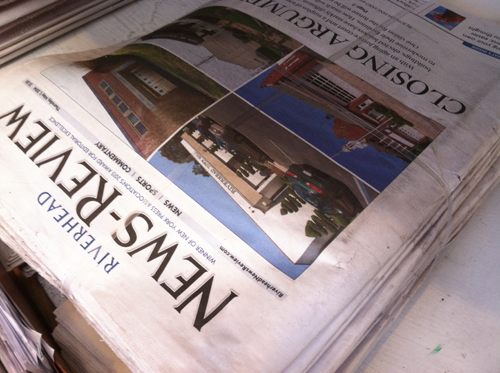Column: The power of the press

If you picked up one of Times/ Review’s newspapers this week, the paper you held in your hands was created by the editorial, advertising and production staffs over a week’s time in our offices in Mattituck and Shelter Island.
On Wednesday afternoon it was sent via mouse click to a building in Shirley in the middle of the Pine Barrens. There, in the early evening, printers with Atlantic Color Corp. began working with our one linked computer fi le.
In the “prep room” two printers were overseeing the loading of aluminum plates into a laser machine, which burned images of eight newspaper pages per plate. These then would be loaded into the press down the hall. It was quiet, the room fi lled with the purring of the plate imaging machine.
One example of technology outpacing the printing industry was right in front of you in the prep room, where just a few years ago there would have been eight workers shepherding this step in the many it takes to make a newspaper. Now there were two.
In the corridor just off the huge press room was a free vending machine dispensing orange ear buds that will dull — almost — the clanging bells and racketing roar of a machine printing 21,000 “books” (newspapers) an hour. In one corner was a hill of giant spools of paper trucked from Canada and in a far corner were four silos fi lled with ink — blue, red, black and yellow
— that, with the printers’ skill and help from computers, will make every color in the book.
Two circular vents hanging from the ceiling were emitting what looked like steam. “Not steam,” said plant manager John Markel. “That’s misting water to humidify the room. Paper’s made out of water, right?”
Mr. Markel, broad-shouldered with a gait suited to a pitching deck, has been a printer for 35 years, starting at age 15 helping his father. His role requires him to manage and work multiple jobs all over the plant. But standing in the middle of the pressroom, he said, “This is my house. This is my comfort zone.”
Comfort, but sometimes on Wednesdays, when all the East End weeklies, plus several newspapers from farther up-island, go to press, it sometimes seems like “standing on a cliff,” Mr. Markel said.
Four printers in dark blue coveralls running the press had ink up to their elbows, confi rming the old adage that printers have to go on vacation to discover they have fi ngernails.
One young printer walked a catwalk above the fl oor, working on the four “towers” of the press. Printer Rich Valek was all over the press room fl oor: here at a central computer console using a touch screen, there at the towers getting a close-up of the run, back down the line checking ink, taking pages from the line to see if the green of grass in an ad was true or the blond hair of a woman in a photo looked genuine.
The continuous running belt is an industrial trapeze act performed at blinding speed, the endless paper flowing up, down, through, around and back again. Even though you’ve seen this in a hundred movies, it’s still a mesmerizing, stop-you-in-your-tracks sight.
But how much longer the awesome and beautiful power of a press will continue to roar is a question everyone involved in the newspaper business debates openly and within themselves, when cornerstones of American journalism are cutting print editions to three days a week and newsrooms everywhere are making do with skeleton crews.
The digital transformation has put printers at risk, with the U.S. Department of Labor predicting that over the next several years close to 13,000 of them will be looking for work.
Eight out of 10 people surveyed by Pew Internet Research said they received news from local TV, 60 percent said they got information online and only 17 percent reported getting news from a national newspaper such as The New York Times or USA Today. The late Ray Bradbury’s prophecy back in 1953 of a “post-literate populace” may be upon us.
In his masterpiece, “Fahrenheit 451,” Bradbury has a character say: “I remember the newspapers dying … No one wanted them back. No one missed them.”
But nothing is that dark. Pew’s research found half of all people surveyed read a local newspaper. And newspapers in one form or another continue to attract people, including Americans 18 to 24. According to Nielsen, almost 60 percent of them read “content” on a range of devices, just not on paper.
The printers working in the press room weren’t hanging funeral wreaths. They were too busy, working with effi ciency, skill and silent pride, putting the deafening machine through its paces. Mr. Markel said that printing was in danger of becoming just factory work, but then he pointed to a young printer and said, “That guy can make or break your day.”
He was standing next to one of the enormous rolls of paper feeding into the machine, with another roll of paper behind it. With fl awless timing, he guided the last few feet of paper from the diminishing roll onto another, splicing it perfectly so there was no break in the press run.
The team didn’t speak, but made only slight gestures and had a kind of telepathy about what needed to be done. The machine, though computerized in most processes, has to be tended by human hands, knowledge and experience.
The press was dialed up to run at 23,000 papers an hour. Then it was throttled back as one printer near the end of the long belt was bent over, timing the paper fl ow. He drew a fi nger across his throat. The press, like a thoroughbred, slowed to a trot.
Mr. Markel took a copy of the Shelter Island Reporter off the line. “Here’s your paper,” he said.

Ambrose Clancy is editor of the Shelter Island Reporter. He can be reached at (631) 749-1000, ext. 18, or via email at [email protected].








